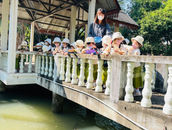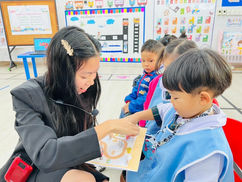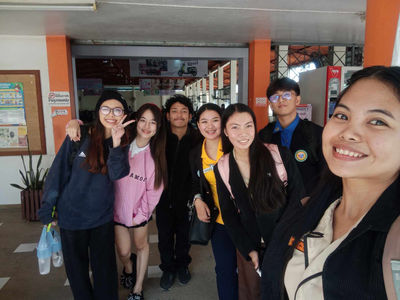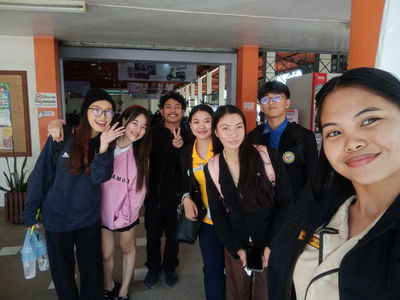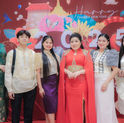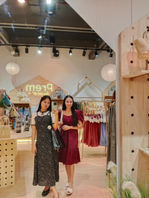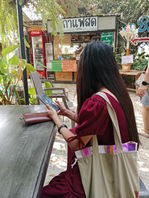


10th Batch
Bachelor of Elementary Education
Lovelin D. Devera
Sawadee khaa! My name is Lovelin D. Devera, and I am a fourth-year college student pursuing a Bachelor of Elementary Education at Capiz State University-Pontevedra Campus in the Philippines. I am honored to be part of the 10th batch of the SEA Teacher Student Exchange Program and I am eager to share my learnings and experiences with you here.


Photo taken after I introduce myself to the Kindergarten 1/2 class.

การเดินทาง
kandoenthang
"Kandoenthang" is a Thai word that means "Journey".
Now, join me as I share my unforgettable journey and experiences in Thailand, a land bursting with culture and adventure! Let's explore their educational system and rich traditions together.
Upon leaving Chiang Mai international Airport, we had a little tour in the city of Chiang Mai before proceeding to our host university.
Our first stop was Kuay Chap Sam Ka Sat, a local restaurant specializing in pork dishes, where we had our first taste of authentic Thai cuisine. Next, we visited Wat Chedi Luang, a beautiful Buddhist temple in the historic heart of Chiang Mai. To end the day, we relaxed at a cozy café near the Ping River, a vital water source for the region, commonly used for transportation and local activities like fishing.
Sneak Peek: Chiang Mai Sweet Little Tour

School: General Information & Academic Administration
CHAPTER I.
SCHOOL PROFILE
Lampang Rajabhat University

We have now arrived to my receiving university, Lampang Rajabhat University.
Lampang Rajabhat University (LPRU) was originally called Lampang Teachers College, was founded on the 9th June 1971 and is located at 119 Lampang-Mae Ta Road, Ban Hua Gnork, Tambon Chompoo, Amphur Muang, Lampang Province.
Lampang Rajabhat University has divided teaching and learning into 7 faculties, (1) Faculty of Education, (2) Faculty of Humanities and Social Sciences, (3) Faculty of Management Science, (4) Faculty of Science, (5) Faculty of Agricultural Technology, (6) Faculty of Industrial Technology, and (7) Faculty of Nursing. And there are some government departments that have the same status as the faculties. Serves to support education management in the other 4 government agencies, namely: (1) Office of the President, (2) Office of Academic Resources and Information Technology, (3) Office of Arts and Culture and (4) Research and Development Institute.
Source: https://en.lpru.ac.th/aboutlpru/
Lampang Rajabhat University is anchored on the following Philosophy, Vision, Identity and Mission:
Philosophy
'University for Local Development'
Vision
To be a learning and creative organization for sustainable local development.
Identity
Volunteer graduate with morality and leading society.
Mission Statement
1. Produce quality graduates have a good attitude. Being a good citizen in society and having the capacity to meet the needs of graduate users.
2. Research to create a body of knowledge and innovation with quality and accepted standards. Focus on integration for concrete benefits.
3. Develop localities according to their potential. The real problems and needs of the community by transferring knowledge, technology and bringing the royal ideas into practice.
4. Build a network of cooperation with all sectors for local development. and to strengthen the strength of community leaders to have morality and ability to manage for the benefit of the public.
5. Effectively manage resources within the university with good governance. ready to support changes for continuous development and still standing and being Thai.










Demonstration School Lampang Rajabhat University
This is my cooperating school, the Demonstration School of Lampang Rajabhat University. It’s just a 10-minute walk from the International Student House, where we stayed and is located within the campus.
Lampang Rajabhat University Demonstration School, a Pre-Primary Level (Pre-Kindergarten Department) was originally a children's home project. It has been in operation since May 2009 with budget support from the Lampang Rajabhat Institute with the aim of being a source of training and experience in various fields for students of the Early Childhood Education Program as well as a source of research and learning for students, teachers, and the general public.
This is where all my cute and heartwarming moments began! I was assigned to Kindergarten 1/2, a pure Thai class under Teacher Pim, my cooperating teacher. At first, I felt a bit anxious since I only knew a few basic Thai words, making communication a challenge. But little did I know, this experience would turn into a fun and unforgettable journey!
The Demonstration School of Lampang Rajabhat University is anchored to the following Philosophy, Vision, Characteristics, Objectives and Highlights:
Philosophy
Virtue brings knowledge to the world with innovative works.
Vision
It is an institution that aims to create people with virtue and bring knowledge by applying the principle of self-sufficiency economy as a guideline for creating innovative works to become international.
Characteristic
"An innovator who thinks and pretends to see the culture"
Objectives
1. To be a source of research and development of teaching and learning.
2. To be a model school for quality teaching and learning.
3. To be a source of study, curriculum development, and demonstration of the use of the curriculum. Innovative Teaching and Learning in Education Measuring and evaluating learners
4. To be a place of practice for professional experience training of the Faculty of Education and other faculties.
5. Be a good role model in teaching and learning management and school administration.
6. Educational services for children of Lampang Rajabhat University personnel Community and Local
7. Promote and maintain arts and culture. Academic services to the community and society
Highlights
Focus on all students with the following special skills:
1. Communicate in at least 2 languages.
2. Play at least 1 piece of music.
3. Play at least 1 type of sport

ACADEMIC SUPPORT SYSTEM
The Demonstration School of Lampang Rajabhat University provides facilities that support learning, including well-equipped classrooms with proper ventilation to ensure a comfortable and conducive learning environment.
In addition to core subjects, the school offers Chinese, English, Music, and PE as part of the weekly curriculum. This gives students the opportunity to not only excel academically but also develop language skills and enhance their innate talents in music and physical education at a young age.
Moreover, the school incorporates educational field trips, allowing students to gain hands-on experiences beyond the classroom, making learning more engaging and meaningful.
 |  |  |
|---|---|---|
 |  |  |
 |
TEACHING SYSTEM
The teaching system at the Demonstration School of LPRU places a strong emphasis on a student-centered approach, where teachers encourage learners to actively participate in interactive activities and hands-on experiences. Instead of simply delivering lectures, teachers provide engaging materials and create a dynamic learning environment that fosters critical thinking and problem-solving skills. They also allow students to explore independently while offering guidance and support whenever they encounter difficulties during activities.
The school also promotes multilingual education by incorporating English and Chinese classes into the curriculum. This initiative aligns with the school’s goal of equipping students with strong communication skills in at least two languages, preparing them for a more globalized world.
Additionally, the school prioritizes holistic development, focusing not only on learners' cognitive abilities but also on their talents and skills. It provides opportunities for growth in all areas of development (physical, emotional, social, and cognitive) by encouraging students to explore, connect with nature, socialize, and enjoy learning in an engaging environment.

Describe your image

Describe your image

Describe your image

Describe your image

CHAPTER II.
Pedagogical Contents
Teaching Methods
01
My cooperating teacher's teaching method includes the use of real objects, allowing learners to observe what they are studying firsthand, analyze its characteristics, feel it with their own hands, and even smell it. She also incorporates hands-on activities and role-playing to enhance engagement and understanding.
For example, during the first week of my observation, the class focused on the five main food groups. As the teacher discussed each group and the foods that belong to it, she provided both pictures and real food samples for the children to touch, taste, and smell. As the week progressed, she introduced an activity where the children made their own omelets, adding various ingredients from the five food groups.
This hands-on experience not only allowed the learners to practice preparing their own food but also helped them understand how to measure ingredients and make healthier food choices.
Learning Materials and Innovation
02
As for learning materials, my cooperating teacher utilizes big charts, visual aids, real objects, flashcards, and storybooks to enhance classroom instruction. She also incorporates songs and games to capture the learners' attention and make lessons more engaging and enjoyable.
All of these materials are effectively integrated into the lessons, creating an interactive and stimulating learning environment. The combination of visual, auditory, and hands-on resources helps cater to different learning styles, reinforcing understanding and retention.
Sources of Learning and Technology
03
Regarding learning sources, kindergarten pupils have their own workbooks, however, lessons are primarily delivered using teacher-made materials to ensure smooth and effective instruction. Additionally, the teacher integrates various digital resources, such as televisions, microphones, and speakers, to enhance interaction and engagement in the classroom.
Authentic Assessment
04
Since we are dealing with Kindergarten 1 pupils, aged 3 to 4 years old, assessments in class primarily consist of hands-on and play-based activities. Informal assessments are also conducted to evaluate key areas of development, including social interaction, behavior, fine motor skills, and cognitive abilities. The teacher assesses these areas through observation and by asking questions related to basic academic concepts during class discussions, ensuring that learning is both engaging and developmentally appropriate.

CHAPTER IiI.
Teaching Plan
Curriculum
The curriculum of the Early Childhood Education School of the Demonstration School of Rajabhat University has been developed for students at the Kindergarten 1 – 3 for a total period of 3 years, 20 weeks per semester
The main goal of the curriculum is to develop the potential of learners to be ready in all aspects according to the important context of life, including:
1. Readiness to take care of themselves,
2. Readiness to become a member of society,
3. Readiness to work,
4. Readiness to learn the world.
Teaching Plan
The school follows its own lesson plan layout, which includes both weekly and daily plans.
The lesson plan covers essential components such as the topic overview, learning objectives, content, key experiences, learning activities, materials needed, music and movement, artistic activities, learning centers, and evaluation.
While the content is quite similar to what we use in the Philippines, the format differs. I find their layout simpler and more efficient, as it streamlines lesson planning without sacrificing essential details.
Unlike the detailed lesson plans I was accustomed to, the layout here focuses more on the lesson overview and key guidelines rather than extensive class information and specifics. This approach allows teachers to have a clear yet flexible structure, making it easier to adapt to students' needs while maintaining the flow of lessons effectively.

CHAPTER IV.
Observation on Teachers
After observing my cooperating teacher’s routine for four weeks, I can confidently say that she meticulously plans her lessons in advance, ensuring that each week follows the assigned schedule and curriculum topics. Her structured approach allows for smooth lesson delivery and effective classroom management, ensuring that learning objectives are met efficiently.
When teaching the class, the teacher begins by checking attendance, followed by a review of past lessons. She then gradually introduces the new lesson, often incorporating songs, stories, or games to engage the students.
I was also amazed at how she ensures that real objects or food are available, depending on the topic. For example, when the class learned about Thai desserts, she prepared a variety of traditional sweets, allowing students to taste and observe their characteristics. Similarly, when discussing transportation, she organized a mini tour of the school’s parking lot, where learners could see different vehicles up close and even experience riding them.
Additionally, the teacher incorporates role-playing activities to reinforce learning. For instance, when teaching road safety, she set up a simulated street scenario where students practiced following traffic signals. When the red light was on, the "cars" stopped, allowing pedestrians to cross. When the green light appeared, the vehicles moved while the pedestrians waited. These interactive experiences make learning more meaningful and enjoyable for the students.
The lessons and materials needed for the day are also prepared in advance. If not, the teacher arrives at school early to set up before class starts at 9:00 AM. One thing that amazed me is that the teachers here seem to manage their workload efficiently, rarely bringing home school-related tasks. Instead, they complete their work during school hours or break times, maintaining a clear boundary between their professional and personal time.
Based on my observation, my cooperating teacher primarily uses play-based and hands-on assessments to measure and evaluate children's learning. For example, when teaching about the five main food groups, she asks students to sort different foods according to their respective groups. This activity allows her to observe how well the learners understand the lesson.
She also incorporates questioning strategies during discussions. Sometimes, she provides clues, and the children have to guess the food being described, making the lesson more interactive and engaging.
Additionally, the teacher includes both group and individual activities, such as coloring and matching exercises. These activities help assess not only the students' comprehension but also their behavior during tasks, creativity, and fine motor skills, such as how they hold and use crayons or pencils.
At times, she encourages students to draw foods they believe are nutritious. Afterward, she asks them to explain their drawings and why they think those foods are healthy. This activity serves as a form of self-expression, allowing children to share their thoughts and reasoning.
Throughout the learning process, the teacher also provides occasional feedback, helping students recognize their progress and areas for improvement.
Planning for Teaching
Preparing Lessons & Materials
Teaching in Class
Measurement and Evaluation


CHAPTER V.
Teaching Practice
Procedures of Teaching
Procedures of teaching starts by planning the lesson, in the second week of the exchange program, Teacher Emma, an american international teacher and our feedback teacher as well already assigned us to think about the possible lesson flow for our teaching in the third week. She presented us the main topic for the week and gave us some insights of possible learning content to be discussed each day. She even let me borrow some of her flashcards that I could use in my transportation lesson.
Meanwhile, my cooperating teacher, Teacher Pim, shared her lesson plan on transportation. However, since it was written in Thai, I had to translate everything into English. In the end, my daily key topics differed from Teacher Pim’s, but that was fine because she taught entirely in Thai, while I focused on teaching vehicle names and transportation-related terms in English.
Comparison of Topics Covered Each Day: Teacher Pim/Mine
Monday – Transportation Overview
Tuesday – The Three Modes of Transportation / Water Transportation
Wednesday – Different Vehicles / Land Transportation
Thursday – Road Safety / Air Transportation
Friday – Review of Transportation and Its Benefits / Weekly Lesson Summary of the Three Modes of Transportation
Once the daily learning content was approved, I started preparing my learning materials and visual aids. Fortunately, all the necessary resources such as a printer, television, glue, scissors, and other supplies for activities were readily available in the classroom.
Time Management & Organizing of Activities
Each day, I am given only 30 minutes to deliver my lesson. I usually begin with a simple greeting, followed by a song related to the topic to serve as motivation. Then, I introduce the new lesson and guide the children in reading key terms. For example, when teaching the meaning of transportation in English, I have them repeat after me.
Next, I present different vehicles based on the day’s content, encouraging students to repeat their names until they can identify them independently. Since 30 minutes is a short period, I typically spend about 15 minutes on lesson delivery, leaving the remaining 10–15 minutes for activities.
The activities usually begin with a group task, such as solving puzzles or sorting vehicles. After that, students engage in individual activities like coloring vehicles, painting, making their own vehicle models using playdough, or assembling cut-out parts of a boat or car.
Fortunately, 30 minutes has been sufficient to complete the lesson and activities. I haven’t encountered any issues with the lesson flow, except when there are unexpected schedule changes.
Problem Solving & Classroom Management
The most common challenge I faced in every class is the language barrier. Since it is a pure Thai class, the students rarely use English, even in their regular lessons. This makes it difficult for me to understand them and clarify their confusion when they ask questions. While Google Translate sometimes helps, it is not always effective because the children often do not repeat themselves. I have attempted to have conversations with them using the app, but since they are not accustomed to it, communication remains a struggle.
Another challenge is keeping the learners focused during discussions. My class is scheduled at 10:30 AM, right before lunchtime, and by that time, the students have already had two other classes. As a result, they sometimes feel tired or distracted, choosing to play or daydream instead of paying attention. To keep them engaged, I constantly remind them to focus or move closer to them to regain their attention. Given their young age (3–4 years old), I understand that their attention span is naturally short, which is expected. Despite this, I put in my best effort to keep them engaged.
By the end of the week, I felt a great sense of satisfaction when the children were able to name some vehicles in English. For me, this was a big achievement, and I truly enjoyed the experience. I am also very grateful to Teacher Pim and Ms. Wun for their support in helping me manage the class, capture the children’s attention, and provide classroom supplies for my learning materials.







Purposes of Practicum
According to SEAMEO, the SEA-Teacher Exchange Project is designed to give pre-service teachers like me, an excellent opportunity to improve our teaching skills and practice teaching in the real classroom setting. This approach not only requires our English abilities to be polished but also provides the chance for us to widen our horizon in the field of education.
Besides, it also brings us in touch with a different educational setting that may appear different from what we're used to have here and, therefore, it helps us adapt with the problems that came up in different learning environments, student’s requirements, and the cultural surroundings. Furthermore, through such experiences, I learned to enhance three significant abilities that a future educator should have: flexibility, creativity, and cross-cultural understanding.
By participating in this program, I have gained firsthand experience in an international teaching environment, allowing me to apply theoretical knowledge, refine my instructional methods, and build confidence as a future educator.
Procedures of Practicum
The exchange period lasted for approximately 28 days, equivalent to four weeks. During our orientation before departure and again upon arrival at our host university, we were informed about the sequence of duties we would be expected to follow throughout the program.
The very first week was spent mostly observing cooperating teachers and familiarizing ourselves in the classroom, the teaching techniques used, and the behavior of the students. On the weekends, we joined in cultural trips to find out more about the people and be part of the local customs and their way of life.
In the second week, we began assisting our cooperating teachers with classroom management, discussions, and other tasks. This phase also marked the start of our lesson planning for the upcoming week, allowing us to prepare materials and align our teaching strategies with the curriculum.
By the third week, we took on full teaching responsibilities, delivering lessons based on the schedule provided by our cooperating teachers. This was the most crucial phase, as it allowed us to apply our teaching skills, interact directly with students, and refine our instructional methods.
The final week was dedicated to reflection, this is where we start evaluating our experiences, challenges, and the things we learned. Along with focusing on our role as teachers, we also continued to be active in the classroom, assisting in the smooth transition of classes as we were getting ready to finish the program.
Outcomes of Practicum
Through this program, I have gained valuable knowledge in the teaching field, particularly in different teaching strategies. One of the most remarkable approaches I observed was the use of real objects in the classroom, allowing students to experience firsthand what they are learning instead of just reading about it. This hands-on method truly amazed me, as I had not encountered it in the Philippines before going to Thailand. It showed me the importance of interactive and experiential learning in engaging young learners.
Beyond teaching strategies, I also learned how to adapt to a new environment, understanding the do’s and don’ts, traditions, and cultural perspectives of my host country. Additionally, I developed classroom management skills and learned to connect with students despite the language barrier. The closeness and bond I built with my students proved that even without verbal fluency, meaningful connections can still be formed through patience, understanding, and genuine care.
Moreover, this program taught me independence, as it was my first time traveling abroad alone. At first, I was unsure of what to do and nervous about what to expect. However, the experience helped me step out of my comfort zone, overcome challenges, and grow both personally and professionally. Looking back, I am grateful that everything went smoothly, and I now feel more confident in facing new experiences in the future. Traveling, once anxiety-stricken me, is now something I would love to do more. This program had fueled my desire to seek new destinations, take on new challenges, and draw wisdom from the many cultures around the globe.
The Challenges of Practicum
Throughout the program, I faced several challenges, including the language barrier, student attention span, unexpected schedule changes, and classroom management. Going to a new country with limited knowledge of the local language was the biggest hurdle. Communicating with my students was difficult since we didn’t fully understand each other, making it challenging to give instructions and clarify concepts. I had to rely on visual aids, gestures, and interactive activities to bridge the gap. Additionally, since my students were very young, their short attention spans made it difficult to keep them engaged especially without a common language. It required a lot of effort, patience, and creativity to hold their attention throughout the lesson.
Another challenge was dealing with unexpected schedule changes, which could be stressful if I wasn’t fully prepared. This experience taught me the importance of flexibility and always being ready to adapt anytime, anywhere. Classroom management was also a struggle, as I had to handle a room full of energetic and easily distracted kindergarteners. Keeping them focused and ensuring that learning was still taking place required strong classroom management strategies and engaging activities.
Despite these difficulties, these experiences shaped me into a more adaptable and resilient teacher. They taught me how to effectively engage and manage children, even without a shared language, and helped me develop essential skills in patience, adaptability, and creative teaching methods. These challenges ultimately made my student exchange journey an unforgettable and meaningful learning experience.
Overall Impression
I am truly honored to be part of the 10th batch of the SEA Teacher Exchange Project, as this has been one of my biggest achievements this year. Through this program, I have gained a deeper understanding of early childhood education, including effective teaching methods suited for young learners, assessment and evaluation strategies, and classroom management techniques. This experience has broadened my perspective on education and strengthened my passion for teaching.
While I faced challenges throughout the exchange, such as language barriers and classroom management difficulties, these obstacles helped me grow into a stronger, wiser, and more adaptable educator. They pushed me to think creatively, be patient, and embrace new learning opportunities.
Overall, this program has been both enlightening and fulfilling. It has empowered me with new skills, expanded my worldview, and deepened my love for teaching. I am incredibly grateful for this experience and excited to continue exploring, learning, and growing in my journey as an educator.
Suggestions for Future Improvement
SEAMEO's SEA Teacher Exchange Program was truly an invaluable experience for student teachers like me. It provided a great opportunity to immerse myself in a new culture and educational environment while enhancing my teaching skills. However, I would suggest extending the duration of the exchange program to allow student teachers more time to explore, adapt, and gain a deeper understanding of the education system in the host country. A longer exchange period would also help us develop stronger connections with students and teachers, making the experience even more meaningful.
Additionally, since the language barrier was one of the biggest challenges faced by many exchange participants, I suggest including short training sessions or seminars before the program begins. These could focus on basic language skills, cultural immersion, and communication strategies to help student teachers feel more prepared and confident in the classroom. By addressing these areas, I believe that future participants can navigate classroom interactions more effectively and maximize their learning experience.
CHAPTER Vi.
Summary and Suggestions

EAGER TO SEE
how I
SPENT MY DAYS
IN THAILAND?
Scroll down more and take a look!
Eager to see how I spent my days in Lampang, Thailand? Scroll down and take a look!

Glimpse of Experiences

Enable sound ↑

LPRU
Orientation Meeting
This is where we had the opportunity to meet the Vice President for Academic Affairs, Assistant Professor Suwanee Chanta.
The other photos include moments with our Cooperating Teachers and the Deputy Director of the Kindergarten Department.
demo school
Little Tour
With Ms. Ying, Assistant to the President for International Affairs, Teacher Emma Buss, FEP Kindergarten Adviser and two other International Student participants from Mariano Marcos State University..
 |  |
|---|---|
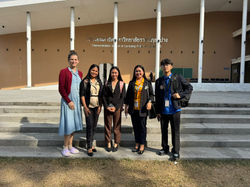 |  |
ourBuddies

Describe your image

Describe your image

Describe your image

Describe your image
first cultural tour
Museum Lampang & Weekend Market near Nong Krathing Park

CHINESE
NEW YEAR
Celebration
Here are some photos from the Chinese New Year Celebration at the Demo School, as well as from International Student Night, where we proudly performed a traditional dance.
second cultural tour
Chae Son Hot Spring
After visiting Chae Son Hot Spring, we stopped by Ms. Ying's parents' house, where her mother weaves and sells beautiful fabrics. We also explored a nearby local market, where we had the chance to try some authentic Thai local foods.
 |  |
|---|---|
 |  |
 |  |
 |  |
In photos
During Teaching Assistanship and Handling of classes
a tour with my cooperating Teacher, ms. pim
During this tour, we visited a souvenir shop, dined at a local restaurant where we tried their unique version of papaya salad, and also stopped by Central Plaza, the largest mall in Lampang.



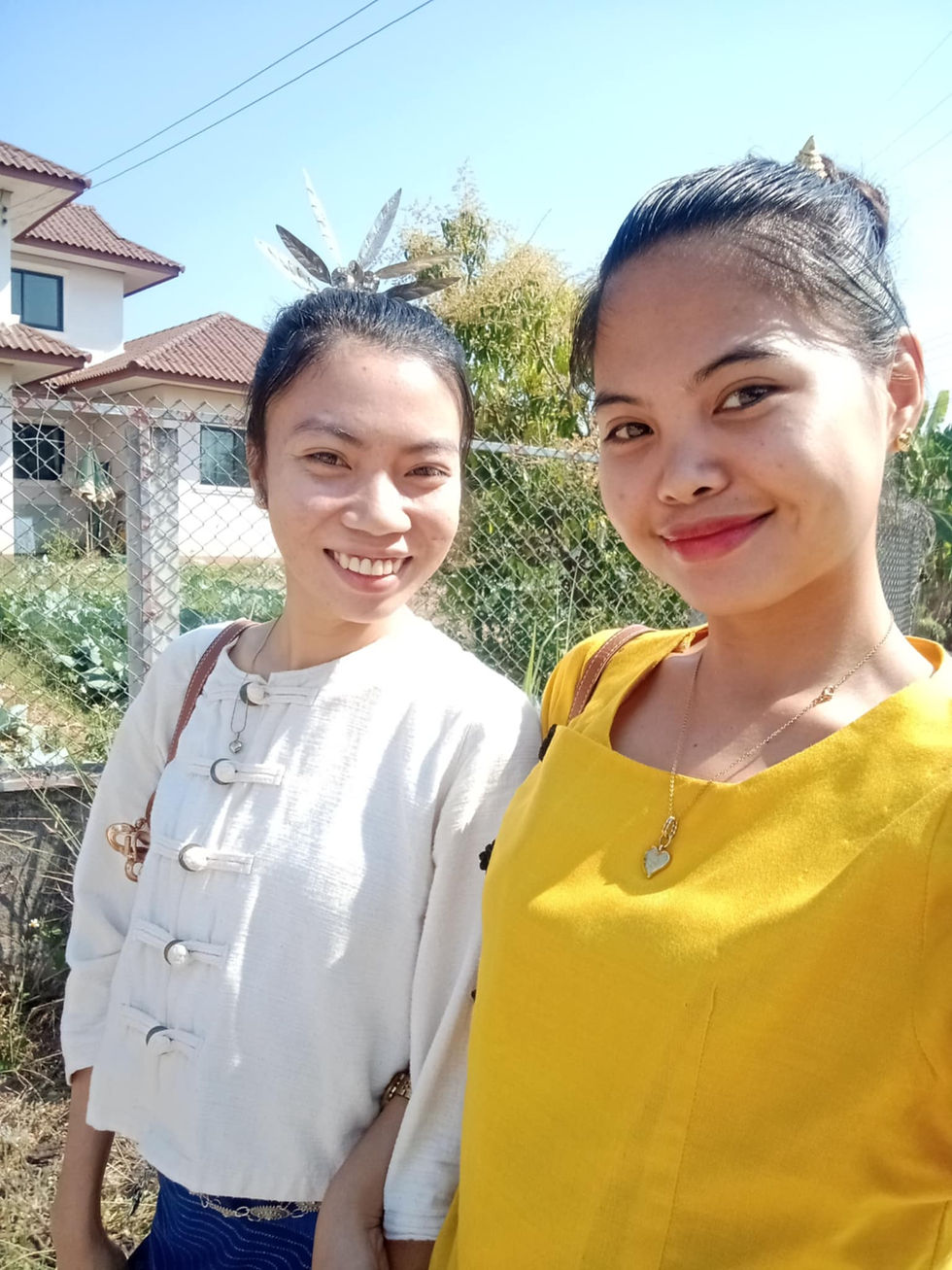





a sweet escape
w/ Ms. Pim & Ms. Emma
On this tour, we traveled to Ms. Pim's hometown to join in their festival celebrations. It was a wonderful cultural experience filled with vibrant traditions and local festivities.
During the day, we also visited three beautiful temples:
-
Wat Pong Luang
-
Wat Luang Nang Ngoy
-
Wat Phra Kaew Don Tao Suchadaram
Each temple had its own unique charm and historical significance, making the experience even more meaningful.
KINDERGARTEN
Educational Field Trip
For the kindergarten field trip, we visited Ann's Farm, and it was such a fun and enriching adventure! The kids had an amazing time exploring, and I felt truly happy to be part of this wonderful experience.










Describe your image

Describe your image


Describe your image
closing
Program & Giving of Certificates
Here, we received our certificates of participation and proof of completion for the International Student Exchange Program. It was a proud and fulfilling moment, marking the end of an unforgettable journey!
last group photo
w/ Ms. Pim, Ms. Wun and Kindergarten 1/2 Pupils
making the most out of our last moments in thailand
at Thai Elephant Conservation Center
The night before our departure, Ms. Ying and Ms. Joy treated us to a wonderful dinner. The following day, we visited an elephant conservation center, where we had the amazing opportunity to feed the elephants and see them up close before heading to the airport.
At the airport, we bid our goodbyes, and to our surprise, Ms. Emma was there to see us off. It was such a memorable end to a great adventure! I’m truly grateful for this experience and for the opportunity to connect with such incredible people.
I hope to see them again, not only in Thailand but also here in the Philippines. Forever thankful for this opportunity, and special thanks to SEAMEO, LPRU, and CapSU for making it all possible.

Khop kHuN kha
ขอบคุณ

Lovelin D. Devera
10th Batch SEA Teacher Exchange Participant





























